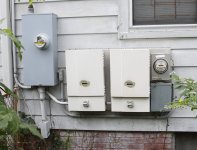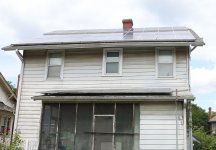SO this is my inverter view as I call it. And then the panels (and yes the back porch needs some work).
Left to right on the inverter view, is the utility meter, then the 3,000 watt string inverter, the 5,000 watt string inverter (2 strings on this one), the solar meter (you might call it the production meter) and below that the system cutoff switch.
The inverters also have turn off switches.
The larger pipe below the utility meter ends up going to my circuit box inside the back porch. With a not, I have a smaller circuit box in my workshop.
Trivia: I am on my 4th utility meter.
The first was the original 1950's era meter, that did NOT go backwards.
The second was installed by the power company when I installed my panels.
The third was installed when the utility computer system got confused and decided that my meter going backwards meant it was a broken meter.
Almost had a fourth after the third one, but managed to convince the utility that time that the meter was NOT broken and it was supposed to go backwards.
And the actual fourth meter was relatively recently installed so it collects all the information in a manner that will eventually allow time of day accounting for net metering purposes.
My system was originally installed in Dec 2009, online in Mar 2010, with 30x 270 watt panels. upgraded in Jun 2015 and fully paid off in Feb 2017 (including interest, all loans, and both storm and squirrel damage. The storm and squirrel damage are unlikely to occur again.
The second image is of the panels themselves. If you note the top most row of panels are slightly higher than the second two rows. This is the result of storm damage which damaged two panels and I only had one spare, so upgrade from 270 to 310 watt panels for the top row and changed the rack system. The original rack system did not like up to its promises, so replaced that with a rack system with a proven track record (as in proven in a Florida Hurricane or two).
With now 8 spare panels, 6 went onto the back porch roof, with micro-inverters. Because at the time, there was still a tree that shaded that part of the roof, so that called for micro-inverters. Optimizers are somewhat newer technology.
I have two spare panels currently, hoping never to need to use them other than for demonstrations.
And a bit of interesting, is that originally the main roof had slate, now it has architectural shingles, as a result the solar panels actually lowered the weight on the roof, instead of the usual adding to the weight, which is why there is a slight upward bend in the middle.
And because I am in Virginia which gets a bit of rain, although still lots of sun, the panels have not yet needed to be cleaned to maintain output. What little dust does accumulate get removed anytime we get more than an inch of snow.
And final note, panels do degrade over time, I planned for this a little bit and thus I used my worst case electricity use, allocated for that, had the solar installed and then have been putting in more energy efficient items in over time. Thus I rarely use more than I produce so far to date. It is my estimate that as of this point my panels are still in the 90% of original range for production and given research indicating degradation slows over time, I expect to still be at over 80% of original production by the 30 year mark.
End result is big fan of solar and love that my electric bill is usually $9.20 a month, with the highest one for this year being $45.95, because of A/C and some equipment in my workshop that sucks electricity.
Of note, I still have natural gas for heating, but then limits to what you can do with a 100 plus year old house in a historic district.
Oh and up until this January, I had been getting SRECs from the Washington DC system, but as of January (i think it is this year anyway) had been getting between $200 and $400 a month form SREC income. Going to miss that as Virginia's is not nearly as high.



